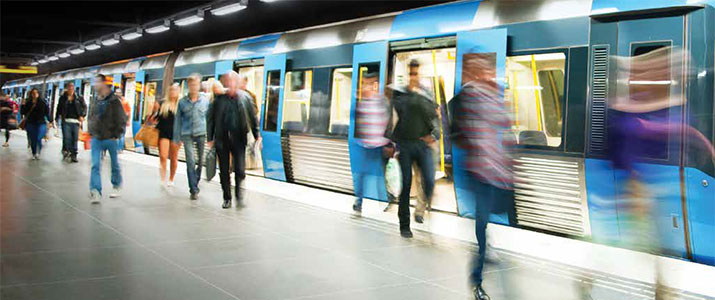
On the Move
Improving transit system safety with integrated security solutions
- By Greg Peratt
- Jul 01, 2014
 Today’s public transportation systems are experiencing growing pains
they haven’t seen in decades. Many transit agencies have experienced
security challenges as ridership has grown, while aging mobile
surveillance systems have struggled to keep up with the migration
from analog to IP-based systems. Legacy technology with inefficient
offload processes and poor video quality compounds the issue and makes the role
of the public safety official harder each day.
Today’s public transportation systems are experiencing growing pains
they haven’t seen in decades. Many transit agencies have experienced
security challenges as ridership has grown, while aging mobile
surveillance systems have struggled to keep up with the migration
from analog to IP-based systems. Legacy technology with inefficient
offload processes and poor video quality compounds the issue and makes the role
of the public safety official harder each day.
However, migration paths to new integrated security solutions are available for
transit agencies to enhance safety and security for passengers and employees, as
well as protect property and revenue streams.
State of the Industry
According to data from the American Public Transportation Association, riders
took a staggering 10.7 billion trips on public transportation in 2013, marking the
eighth year in row that more than 10 billion trips were taken on public transportation
systems nationwide. In fact, 2013 annual public transit ridership numbers
were the highest recorded in 57 years and represent an increase of more than 37
percent since 1995, outpacing the national population growth of 20.3 percent.
Skyrocketing gas prices, the public’s increasing demand for environmentally
conscious transit solutions and a generation nearing retirement are just a few of
the many factors that have led to this spike in demand, and we see no signs of this
trend slowing.
Within this same eight year period that ridership has soared, crimes against
passengers and employees have continued to increase significantly, as well. Issues
such as fare evasion, revenue theft by employees and crimes against transit property,
like vandalism and graffiti, further complicate the role of the transit security
official and transit system administrators. To make things worse, the threat of a
terrorist attack remains an ever-present reality for many metropolitan transit systems,
evidenced by the increasing care and redundancy built into the security plans
of recent high-profile public events such as the Super Bowl.
Legacy analog video formats of yesteryear have compounded these problems
even further. Failure rates, poor video quality, data security and maintenance issues
have all significantly affected the ability of transit administrators to streamline
operations, creating countless hurdles for law enforcement seeking to investigate
crimes. Inefficient offload processes not uncommon on public transit systems are
costly, requiring countless man hours to manually retrieve video from hard disks
or DVRs as part of a process that jeopardizes the integrity of video data required
for evidence, leaving transit administrators and security officials spread too thin.
Analog to IP Convergence Serves as a Turning Point
In recent years, the shift from analog video formats to IP systems has paved the
way for integrated, IP-based, mobile, video surveillance solutions. Driven by increasing
demand for advanced technologies such as high-definition video, thermal
imaging and video analytics, the security industry has been pushed to develop
cutting-edge systems that breathe fresh life into America’s dated security infrastructure.
The public transportation industry has finally reached a turning point
that will allow transit safety officials to deploy solutions that deliver the increased
mobility, situational awareness and security they need to keep pace with the future
of transit system security.
A glimpse of this future can be observed in the case of the Denver Regional
Transportation District (RTD) Transit Police Division. After years of struggling
with a cumbersome, costly video surveillance system, RTD is in the process of deploying
an integrated transit security solution built on IP-based network cameras.
This new solution is replacing RTD’s aging analog-based system to enable staff to efficiently access high-quality video
evidence to better protect riders, drivers
and physical property, as well as to
improve the investigation of criminal
activity, safety violations, accidents and
liability claims.
A Truly Mobile Video
Surveillance Solution
Mobility is perhaps the most obvious
advantage of using IP-based solutions
over analog devices, and RTD is a perfect
example of how it can be achieved
for transit security. Leveraging LTE
cellular broadband, officials are able
to access live video streams anywhere,
anytime from their IP-enabled devices
of trains and buses at their command
and control centers or in the field.
For example, in the event of an
emergency, law enforcement can tap
into video feeds from a public transit
vehicle remotely from their patrol cars,
using their laptops and tablets to evaluate
the situation to better apprehend
suspects or secure the property. As a result,
transit safety officials benefit from
the ability to mobilize their workforce
and streamline communications with
first responders in real-time.
By leveraging existing IP network
infrastructure, integrated security solutions
also offer transit security officials
the ability to automatically offload video
recordings. A key benefit of the RTD
solution is the ability for staff to quickly
and wirelessly offload flagged video files
of specific incidents from buses’ in-vehicle
recorders. Instead of relying upon
bus drivers and maintenance crews to
manually remove hard drives from their buses and spend countless hours manually
reviewing videos to investigate an
incident, administrators can now take
advantage of wireless connectivity to
retrieve video data recordings without
putting the equipment at risk. In turn,
administrators are able to reduce the
time and costs associated with system
maintenance, and streamline video
transfer processes altogether.
Maximize Situational
Awareness
In addition to much improved offload
processes, IP-enabled, mobile, video
surveillance solutions offer the highdefinition
video quality needed to maximize
situational awareness within public
transportation systems. Using full HD
1080p and HD 720p network cameras
inside and outside of each bus, RTD
administrators have integrated their new
IP-based system with other hardware
and software components to create an
end-to-end mobile security solution.
Whereas legacy systems can be limited
by the storage capacities of analog
recording equipment, IP-enabled solutions
record video data digitally, which
requires a smaller physical footprint
and delivers the storage officials need to
capture the data-rich video files generated
by HD devices.
As many transit administrators
know, the most critical area of any
transit vehicle—whether a train, bus
or railway car—is the driver’s seat. By
installing audio-recording security devices
within the driver’s booth, public
transportation officials are able to better
protect staff and ensure that activity
within the vehicle complies with all
laws and codes of conduct. These nextgeneration
devices can even be used to
help train new employees or resolve
fraudulent injury claims.
Enabling Video Analytics
for Improved Business
Operations
Video analytics is yet another benefit
offered by integrated transit security
solutions. For transit systems seeking
to not only protect people, property
and assets but also optimize business
operations, video analytics capabilities
can deliver such benefits as face detection
and face matching, auto image stabilization,
as well as automatic alerts in
the event of tampering.
Examples of the current benefits of
this emerging technology include the
ability to determine past offenders and
analyze ridership patterns. New applications
are constantly being realized.
While not every public transportation
system will require such functionality
today, integrated transit security solutions
provide officials with the flexibility
to deploy such technologies as need
grows and technology matures.
With demand for HD video and the
adoption of video analytics systems
on the rise, data security has become a
chief concern for public transportation
systems. To overcome these concerns,
the Denver RTD system is leveraging
video management software for viewing
and managing video files, enabling
administrators to integrate them with
various other video and audio sources
and case files to create a unified event
timeline, dramatically reducing the time spent on incident investigations.
Comprehensive Data
Security for Enhanced
Transit Safety
For security professionals investing in
new security infrastructure, the integrity
of video data is often only as secure
as the devices themselves, which is why
equipment reliability and ruggedness
is among the top concerns of transit
administrators. Between challenging
climate conditions, vandalism and the
wear-and-tear observed over years of
constant use, mobile video surveillance
systems can take a beating.
Recognizing the challenges of mobile
video surveillance, RTD has installed
ruggedized, vandal-resistant
cameras that are specially engineered
to withstand vibration, shocks and impacts.
IP66-rated for weather, shock,
impact and vandal resistance, each of
the new cameras are equipped with
anti-vibration mounts to ensure longterm
performance, while cameras on
the buses’ exteriors are even secured
in purpose-built, shroud housings for
added protection against impact and
extreme temperatures.
Lastly, integrated transit security
solutions are developed around existing
IP network infrastructure, allowing
officials to expand their mobile video
surveillance efforts beyond anything
previously possible with legacy systems.
With the help of IP connectivity, these
new systems are engineered around an
open architecture, eliminating much of
the cabling and maintenance required
by analog systems. Ultimately, these
benefits make the systems not only
easy to deploy, but also provide a way
for administrators to expand or downgrade
their investments as ridership
trends change.
The Future of Public
Transportation Security
Integrated transit security solutions
with IP-based video surveillance systems
are the future of transit system
safety. Whereas public transportation
systems were in years past limited by
closed architectures, the future of transit
safety embraces the growth of public
transportation and a need for increased
public safety.
Leveraging IP connectivity to deliver
live video streams to transit safety
officers at headquarters and in the field,
integrated solutions enable administrators
to improve safety for passengers
and transit workers, protect physical
assets and aid in the investigation of
liability claims. Offering an open architecture
that is designed to accommodate
growth, these solutions are allowing
public transportation systems,
such as Denver RTD, to advance with
the industry and enjoy the enhanced
mobility, situational awareness and security
they require.
This article originally appeared in the July 2014 issue of Security Today.